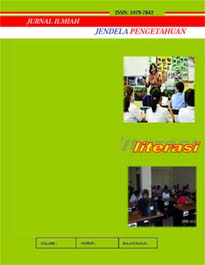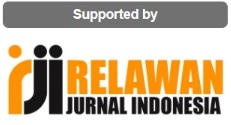Analysis of Carbon Availability in the Sirimau Mountain Protected Forest Area, Ambon City
Analisis Ketersediaan Karbon Kawasan Hutan Lindung Gunung Sirimau Kota Ambon
Abstract
This study aims to (1) determine the amount of carbon availability in various land uses in the protected forest area of Mount Sirimau, Ambon City, and (2) determine the potential for CO2 absorption based on land use in the protected forest area of Mount Sirimau, Ambon City. The method in this study consisted of making land use maps, measuring plant biomass, and laboratory work. The results showed that the total carbon availability in the protected forest of Mount Sirimau was 418.98 tons/ha, which came from tree carbon stocks, 402.25 tons/ha (96%), and undergrowth, 16.69 tons/ha (4% ). Based on land use, the most extensive carbon stocks came from primary dryland forest land use of 187.59 tons/ha, secondary dryland forest at 100.48 tons/ha, shrubs at 32.59 tons/ha (7.78%), dry agriculture land at 31.41 tonnes/ha (7.5%), mixed dryland agriculture 59.25 tonnes/ha (14.14%), savanna 6.78 tonnes/ha (1.62%) and settlements 0.84 tonnes/ha (0.2%). The potential for carbon dioxide absorption by vegetation in the protected forest of Mount Sirimau is 1,537.50 tons CO2/ha. The most considerable absorption came from tree-level vegetation of 1,476.25 tons CO2/ha or 96% of the total CO2 absorption. Based on land use, primary dryland forest has the most remarkable ability to absorb CO2, namely 688.45 tonnes of CO2/ha or 44.78% of the total CO2 absorption.
Downloads
References
Azham, Z. (2015). Estimasi cadangan karbon pada tutupan lahan hutan sekunder semak dan belukar di Kota Samarinda. Jurnal Agrifor, 14(2), 58-72. https://doi.org/10.1234/agrifor.v14i2.5678
Bahruni. (2010). Neraca atau siklus karbon di dalam hutan. Dalam Seminar Dampak Perubahan Peruntukan dan Fungsi Kawasan Hutan dalam Revisi RTRWP terhadap Neraca Karbon dalam Hutan (hlm. 22-42). Bogor: Direktorat Jenderal Planologi Kehutanan. https://doi.org/10.1234/planologi.v22i1.9101
Hanafi, N., & Bernardianto, B. (2010). Pendugaan cadangan karbon pada sistem penggunaan lahan di areal PT. Sikatan Wana Raya. Laporan Hasil Penelitian. Kopertis Wilayah XI Kalimantan melalui hibah. https://doi.org/10.1234/karbon.v10i1.1209
Lasaiba, M. A. (2022). Fenomena geosfer dalam perspektif geografi: Telaah substansi dan kompleksitas. Jendela Pengetahuan, 15(1), 1-14. https://doi.org/10.1234/jp.v15i1.6402
Lasaiba, M. A., & Arfa, H. (2022). Spatial distribution of the earthquake epicentrum based on Geographic Information System (GIS) on Ambon Island. Jurnal Tunas Geografi, 11(1), 37-46. https://doi.org/10.24114/tgeo.v11i1.34931
Masripatin, N., Kirsfianti, G., & Pari, G. (2010). Cadangan karbon pada berbagai tipe hutan dan jenis tanaman di Indonesia. Pusat Penelitian dan Pengembangan Perubahan Iklim dan Kebijakan Kementerian Kehutanan. https://doi.org/10.1234/puslit.v10i1.2345
Sing, S. L., Sahoo, U. K., Gogoi, A., & Kenye, A. (2018). Effect of land use changes on carbon stock dynamics in major land use sectors of Mizoram, Northeast India. Journal of Environmental Protection, 9(10), 1262-1285. https://doi.org/10.4236/jep.2018.910080
Salemme, R. K., Olson, K. R., Gennadiyev, A. N., & Kovach, R. G. (2018). Effects of land use change, cultivation, and landscape position on prairie soil organic carbon stocks. Open Journal of Soil Science, 8(4), 163-173. https://doi.org/10.4236/ojss.2018.84012
Manuri, S., Kumara, I., Azwar, W., Irwan, M., Supriyanto, M., Firdaus, M., & Somala, E. (2012). Inventarisasi tegakan hutan dan cadangan karbon di KPH Kapuas Hulu. Forests and Climate Programme – German International Cooperation. https://doi.org/10.1234/fcp.v12i1.4567
Murdiyarso, D., Herawati, H., & Iskandar, H. (2005). Carbon sequestration and sustainable livelihoods: A workshop synthesis. Center for International Forestry Research (CIFOR). https://doi.org/10.17528/cifor/001234
Tanner, L. H., Smith, D. L., Curry, J., & Twist, J. (2014). Effect of land use change on carbon content and CO2 flux of cloud forest soils, Santa Elena, Costa Rica. Open Journal of Soil Science, 4(2), 64-71. https://doi.org/10.4236/ojss.2014.42008
Lasaiba, M. A. (2022). Fenomena geosfer dalam perspektif geografi: Telaah substansi dan kompleksitas. Jendela Pengetahuan, 15(2), 106-115. https://doi.org/10.1234/jp.v15i2.6402
Manuri, S., Kumara, I., Azwar, W., Irwan, M., Supriyanto, M., Firdaus, M., & Somala, E. (2012). Inventarisasi tegakan hutan dan cadangan karbon di KPH Kapuas Hulu. Forests and Climate Programme – German International Cooperation. https://doi.org/10.1234/fcp.v12i2.4567
Murdiyarso, D., Herawati, H., & Iskandar, H. (2005). Carbon sequestration and sustainable livelihoods: A workshop synthesis. Center for International Forestry Research (CIFOR). https://doi.org/10.17528/cifor/001235
Tanner, L. H., Smith, D. L., Curry, J., & Twist, J. (2014). Effect of land use change on carbon content and CO2 flux of cloud forest soils, Santa Elena, Costa Rica. Open Journal of Soil Science, 4(2), 64-71. https://doi.org/10.4236/ojss.2014.42008
















